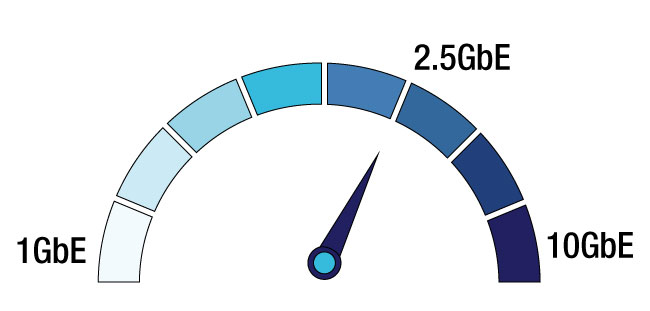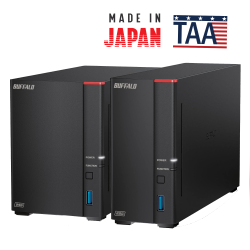2.5GbE: An Affordable Multi-Gigabit Boost for Your Network
Gigabit Ethernet (1GbE) has been around for decades, but with increasingly bandwidth-intensive applications generating larger data files, businesses and consumers alike have been demanding network speeds beyond simply meeting their data needs. With multi-gigabit Ethernet equipment falling in price over recent years, many businesses are considering making the leap from 1GbE to multi-gigabit to get more out of their networks. Learn about our entry level 2.5GbE NAS.

Multi-gigabit exists in a spectrum of 2.5GbE, 5GbE, and 10GbE, and each higher level will incur higher setup costs. 10GbE is the highest end of multi-gigabit Ethernet, and it will require special cabling and expensive equipment. If you are ready to commit to it, Buffalo offers affordable NAS devices with native 10GbE support for SMBs looking to dive into the deep end for network improvement. However, the high costs of 5/10GbE equipment may still present a significant barrier to entry for businesses that do not have data center-sized IT budgets. For this reason, Buffalo recommends 2.5GbE as a cost-effective upgrade that will still provide a notable network performance increase from 1GbE without incurring significant costs.
How 2.5x Bandwidth Boosts Can Help You
All businesses (SMBs especially) often face network bottlenecks that severely hinder productivity. No matter the size of your office, any network will benefit from more bandwidth. You would be hard-pressed to find anyone complain that their network connection is too fast.
Upgrading from 1GbE to 2.5GbE means a network that is 2.5 times faster, enabling network possibilities that were not feasible before. A faster network means increased data transfer speeds, allowing for faster data backups and smoother remote work. Common daily operations such as video production/editing, database management, and NAS storage and backup will all benefit from more bandwidth by allowing you to access and backup data faster. You can also support more stable concurrent application sessions for more stable workloads.
Increased bandwidth also means more optimized virtualization. By allocating more bandwidth per virtual machine, you can increase VM operations and application speed. Customers and remote employees will also enjoy smoother data access, increasing productivity.
Before You Upgrade
Having a faster network does mean that you should have the proper environment to take advantage of it. If you are upgrading from a 1GbE environment, you will need to check your hardware to make sure all your network components can accommodate for 2.5GbE.

Connectivity Hardware
2.5GbE is a very attractive upgrade option because it does not require any specialized cabling—the ubiquitous Cat5e cables will suit it just fine. However, this does depend on the condition of the cables. If you are using very old or very poor quality Cat5e cables, they may not support 2.5GbE connectivity. This is also true of networking gear: if you are using older network hardware, you should check to make sure they support 2.5GbE, even if they are multi-gigabit switches. Since IEEE’s 2.5GbE/5GbE standard wasn’t ratified until 2016, networking hardware manufactured before then may not recognize 2.5GbE, and will drop any traffic to 1Gbps instead.
If you are looking to upgrade to multi-gigabit switches for the first time, you should consider how much you are willing to invest into the future of your network. Prices on multi-gigabit switches have been dropping, and even though a 10GbE switch may seem excessive, this ensures that you will futureproof your network infrastructure. It is best to consider switches that are secure and flexible enough to handle your traffic needs without breaking the bank.
For client devices such as PC or NAS devices, make sure they also support multi-gigabit Ethernet. Some NAS devices are equipped with native multi-gigabit ports. If they are not, you can use 2.5GbE PCIe expansion cards to connect them to the network, or use USB adaptors that will easily connect the devices to the network with no hassle. Both options are economical and flexible.
In short, make sure your entire network environment, including routers, switches, and connectors, are equipped to handle connection speeds faster than 1Gbps in order to achieve 2.5GbE connectivity. Every component counts: if you equip all your devices with 2.5GbE adaptors and forget about that gigabit switch in the corner, you will end up still contending with only 1Gbps.
Other Hardware
To further prevent bottlenecks, make sure your PC/NAS devices can handle the boost in bandwidth. Faster networking requires faster storage. It does your business no good to have blazing fast transfer speeds only to have a bottleneck form at a drive with slow write speeds. If using NAS storage, it is a good idea to consider putting them into an appropriate RAID mode so your storage complements faster data transfers and backups.
If you are working with a smaller IT budget, it is also important to note that 2.5GbE equipment will typically consume more power and generate more heat. When upgrading your network, make sure you take the precautions and make appropriate upgrades for proper ventilation/cooling. Otherwise, you may open yourself up to an accidental data disaster.
Affordability
2.5GbE is a very attractive upgrade option for many small businesses for its affordability and cost-effectiveness. As mentioned, there is no rewiring required—you can use your existing Cat5e cable for your current Ethernet connection. You will need to make sure that all your hardware components support 2.5GbE, but you can find affordable 2.5GbE switches and adapters (both PCI and USB) at a fraction of the cost of 10GbE equipment.

Futureproofing Your Network
In short, multi-gigabit Ethernet can enable a substantial bandwidth upgrade for many networks. Since 5/10GbE can represent a prohibitively expensive upgrade for some SMB environments due to specialized cabling and equipment, 2.5GbE can provide a much more simple and economical method to increase network performance for those who are not ready to commit to the deep end of 10GbE. By using the same Cat5e cables that are already widely-installed around the office, small businesses can enjoy notably faster network speeds for their multi-user network environment at much lower costs.
Buffalo Americas offers innovative multi-gigabit Ethernet switch products and NAS storage products with native 2.5GbE Ethernet ports (TeraStation 3020 Rackmount/Desktop, LinkStation SoHo 700 and LinkStation 700). Our network and storage solutions are reliable and secure, and backed with award-winning customer service, including 24/7 North America-based support. Responsible for many industry firsts, Buffalo has over four decades of networking and computer peripheral manufacturing and design experience.




